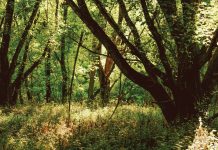
Photograph by CarlPfranger / iStock / Getty Images Plus
When the previous Atlanta City Council adjourned at the end of 2021, it left an important piece of business unfinished: a long-sought revision of the city’s Tree Protection Ordinance. A part of the city code since 2001, the ordinance aims to protect Atlanta’s status as a “city in the forest” by preserving that forest, putting into place guidelines for landholders, developers, and homebuilders. But much has changed in Atlanta in the last two decades, and there’s widespread agreement that the old rules are no match for the city’s current growth. In recent years the City Council has tried rewriting the law, though such efforts have yet to bear fruit.
What does the tree ordinance do—and what is it not doing?
If you want to remove a tree greater than six inches in diameter in the City of Atlanta, you need to apply for a permit and pay a fee into a fund that goes toward, among other things, replanting trees elsewhere—with the ultimate goal that Atlanta doesn’t experience a net loss. One problem is that the fee schedule is two decades old; currently, it costs $100 plus $30 per diameter inch, with fines for the illegal removal of individual trees capped at $1,000. For developers, those fees aren’t really an obstacle—just a part of doing business.
“One of the biggest critiques of the current ordinance is that it’s very transactional,” says Judy Yi, a spokesperson for Trees Atlanta, one of the groups pushing for an ordinance with more teeth, including fees that better reflect the value of Atlanta’s greenery. The current ordinance also treats most trees the same, regardless of size or species; advocates would like to see greater emphasis placed on protecting certain “priority” trees that provide the most benefits. A replanted sapling, for instance, doesn’t have nearly the value as a centuries-old oak with an enormous canopy.
But let’s not miss the forest for the peach trees here: What’s the bigger picture?
Between 2015 and 2020, the Atlanta metro was the third-fastest-growing urban area in the country—the kind of growth that, unchecked, threatens local vegetation. As the tree-protection organization City in the Forest points out, development norms are also different than they were when many Atlanta homes were being built prior to the 1960s. Back then, builders favored small lots on flat grades and retained trees for shade; now, with bigger houses and lots, clear-cutting and mass grading are more common. Most trees in Atlanta are in areas zoned for single-family homes.
The 2020 city planning document Atlanta City Design: Nature reaffirmed a preexisting goal for Atlanta’s canopy cover to be 50 percent—meaning that, when trees are in full leaf, they shade half of the city’s surface area. It’s currently a few percentage points less than that and shrinking: A 2018 study found that the city’s canopy cover was 46.5 percent—almost 1.5 percent smaller than a decade previous. This issue is far from exclusive to the Atlanta metro. Cities around the country have recently updated or are in the process of updating their tree protections. In our immediate neighborhood, Decatur has a canopy cover of over 57 percent, with a goal of 65 percent; the city updated its own tree-protection ordinance this year. Brookhaven, which has experienced a canopy decline in recent years, also recently revised its ordinance—in the face of pushback from developers, who say it’ll slow growth in the thriving town.
Why is the canopy important?
Beyond the aesthetic pleasures they provide, trees are immensely valuable, in cities as elsewhere: They cool surface temperatures, their roots stabilize soil and prevent erosion and flooding, and, of course, they absorb atmospheric carbon that would otherwise contribute to global warming. As the climate crisis worsens, much has been made of theoretical technical fixes, including massive carbon-capture projects. But, as environmentalists are fond of pointing out, there’s really only one carbon-capture technology that’s been proven to work at massive scale. It’s trees.
What’s the latest on updating the ordinance?
The city first tried to revise the tree ordinance in 2014; the most recent push followed the publication of Atlanta City Design: Nature, and it’s become a perennial issue. Last year, Atlanta’s Planning Department proposed a revision that addressed some of the shortcomings of the original, including designating a category of priority trees. But advocates thought the provisions weren’t strict or specific enough, and some drafted their own, alternative ordinance. Despite promises to take it up last summer, the council didn’t return to the issue by the end of its session and, in December, voted to defer action. This year, it’s on a list of goals for the council’s Community Development/Human Services committee, which says it’s aiming for a revised ordinance that “strikes a balance between strong protection of our tree canopy and increased density in our city.”
This article appears in our April 2022 issue.














